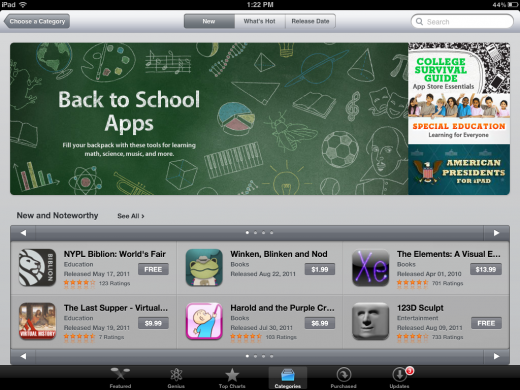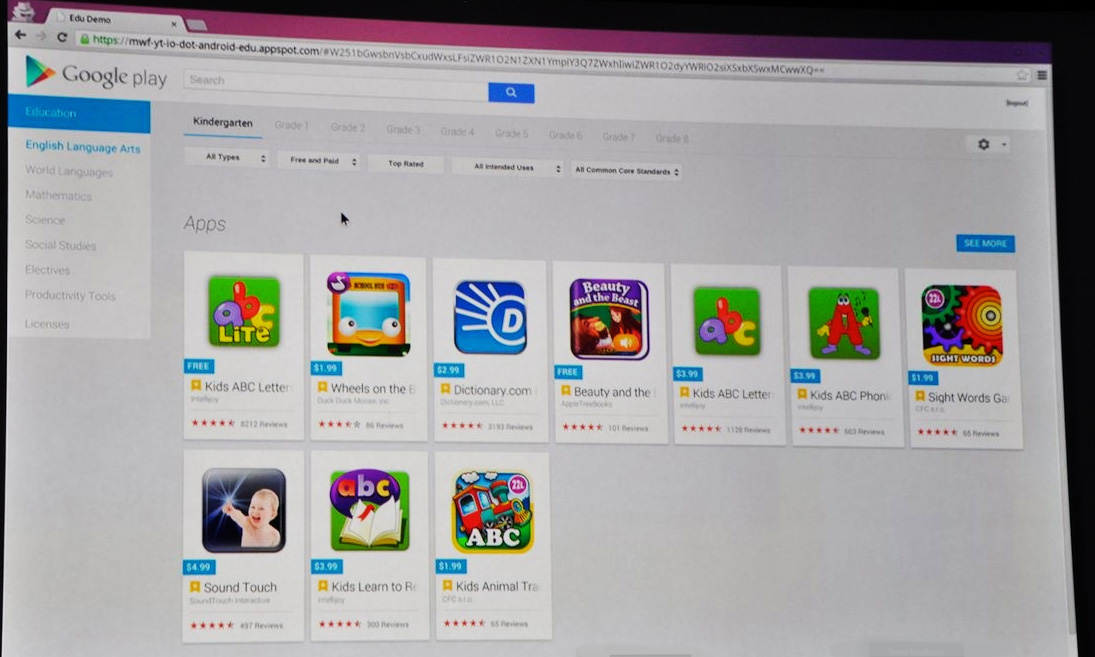Publishing a game used to be an expensive affair. Not simply the production costs, but distribution, store placement and marketing to the game press and consumers all took major upfront costs. Now, It’s an upload to Google Play or the App Store and distribution is free, publication is essentially free and getting found by your audience is… well, a different story.
“In general, if you are looking for great apps which are not awful – which seems like a reasonable question to ask – your options are pretty limited,” said Toca Boca’s CEO Björn Jeffery.
“It’s quite difficult still with discovery broadly – how do I find a great app for my kids, no matter what I am looking for – educational or whatever? How do I find a filter or an editor or a curator or something like that that can point me in the right direction? And at the moment it is almost only the platforms themselves.”

The App Store and Google Play have made it easier to publish games, but getting those apps n front of customers is a more complicated affair.
The challenge facing game developers has shifted from finding a publisher to take their games and distribute them to finding ways to build audience and stay high enough in the rankings of the App Store or Google Play to matter.
When people say distribution there are a few parts to that; it’s discovery, it’s structuring the right conversation around discovery and what quality products are, it’s about what the buying model is, and it’s about who shares in that revenue. The App Store is amazing for being able to upload a file and then millions of people a few hours later across the whole globe can download it. But it’s not ideal for some of those other components.
Jacob Klein, Motion Math Co-founder
Strategies for Findability
In the last year we have talked to a lot of developers and heard what they have tried, what has worked and what hasn’t in terms of sticking out from the crowd.
First, we have heard from VC’s and developers that marketing and a promotions strategy cannot come last in the list of things a developer needs to get done. It needs to be ingrained in the process.
Even the first pitch of a game, according to New Schools Venture Fund’s Shauntel Poulson, must answer a couple of core questions: “There are always a million-and-one math games, so how is your math game very specifically different? And if it is significantly different, how can it be marketed so it can be elevated above the other million math games?”
So uniqueness of a game subject matter, design or approach can help but uniqueness can only get you so far. As Poulson notes, you need a marketing plan as well. Here we have heard from a lot of developers who have worked within the co.lab accelerator and they came out with a new appreciation for the depth to which the successful app companies focus on the marketing question.
Speaking of math apps, it may make sense to hear from Motion Math, a firm that has seen 3 million downloads of its apps – almost all of them are paid. One of the company’s co-founders, Gabriel Adauto, said it was while they were part of co.lab that they got to see how Zynga approached “Cutting through the clutter.”
“What we observed at Zynga is that they have everyone working towards this. You have the marketers, who are most involved, you have the product managers who are designing features that will move the needle and give the marketers something to talk about, and then you have the creative people who are thinking about how you really appeal to the user,” he said. “If you don’t appeal to the user, the marketing is just lipstick on a pig. It takes everyone to really make it happen.”
Building a Brand
Whether it was Toca Boca or Tinybop, developers have stressed the need to build a brand rather than just a game.
Toca Boca, a firm that spent more than a year studying the App Store before it launched its first app, made the idea of brand core to its efforts. Jeffery said they have consciously built a “wide portfolio of different kinds of themes and play patterns, but they’re all under the same Toca Boca umbrella.”
He equated it to “Searching for a brand and then finding a wide range of things, akin to how an uncle or an auntie are like, ‘I’ll buy something from Lego. That will be great.’ What in the Lego catalogue is almost less important. It’s more like Lego is normally good. That’s a safe bet… I can trust it.”
What’s good about that is it’s good for consumers because it is an easier way to distill what’s good or not. It’s good for developers because it keeps us on our toes because if you buy something from us or from Lego that’s really bad than you are going to think twice before going back. So that means the pressure is on that every product that you make has to be as good or better than the expectations of your customers.
Björn Jeffery, CEO, Toca Boca
At Brooklyn-based Tinybop, Raul Gutierrez agreed that a brand is what can last longer than one hit app, saying “it’s really important for us to focus on brand, and as we grow, to have a very strong and consistent brand presence so that with each app people become aware of the other apps that are out there in the system so that it eventually allows for cross-marketing between apps.”
So, what are some of the tips we have heard these past few months?
- Think about What Appeals to the Stores
The editors at Google and Apple have a huge say in whether your app dies a quick and quiet death or has a chance to score big.
Justin Hsu at Marco Polo perhaps best described the considerations of these gatekeepers when he said the entire selection by Apple was “an opaque process.” But it is clear that there are certain things the curators value – creativity, uniqueness, artistry.

Google is trying to curate particularly effective educational apps in its quest to build Google Play for Education.
But it’s also important to consider how they think about their customers. So, when Google Play for Education launched they made one of the primary missions was to create a much more edited app store.
Submitting the app remains the same, but for education apps, Google then allows teachers to use the app for some time and decide how effective it is and what classes, grade levels and Common Core standards the app helps address. Apps that rise to that level then get featured prominently in the Google Play for Education store.
“We feel like it has been too hard for innovative developers to get their content into schools and too hard for teachers to find that content and get it to the right students,” he said.
For that curated section we pretty much inverted the normal app process. Instead of making it easy to submit and hard to get discovered, let’s make it a little bit harder to submit; let’s make it that you really have to be above an educational bar and then we will make easier to be discovered.
Rick Borovoy, Product Manager at Google
- Consider Freemium to Spread the Word
Especially if you are developing or deploying a series of games or building more of a brand, the idea of releasing a freemium version of a learning game will increase the exposure of the app and your brand, but will probably not convert to sales of in-app purchases.
Tanner Christensen launched a brain-training app called Brainbean. He admitted that the in-app purchase rate was very low – about 2 percent – but credits the freemium for giving his work wider exposure.
“It has given me an opportunity to connect with more than half a million people around the world. Not many other developers can say that their app will reach one million downloads within four months,” he said. “Taking that opportunity and utilizing it to create exposure around future app updates or my next project is huge, I think.”
-
Make Friends (and Then Use Them)
Several game developers we spoke with found that they have succeeded by viewing their customers more like a community and less like a business transaction.
Antonio Gould of the Usborne Foundation said that hiring a community manager made a huge difference in their Teach Your Monster to Read app sales, saying they “rocket boosted that process to make sure we’re being responsive to people replying on social media. With games sales, you often see a massive spike at the beginning, but our game, starting with no-one and building from there, when you take out the effect of the school term, it goes up in a linear fashion.”
Motion Math as well has been out meeting with teachers to spread the word about their apps.
“Almost all our growth so far has been organic, and we’re excited to experiment with other marketing efforts going forward but so far it’s been organic growth,” Jacob Klein said.
We go to conferences, which has been great for meeting a lot of teachers in person and get their feedback and to show our products off to teachers who might not be aware of them yet. We also have a mailing list of our super-fan educators, and then locally we know a lot of teachers in the Bay Area from our user tests.
Jacob Klein, Motion Math
-
All Press is not Created Equal
Getting good reviews can be a key way to get word out about your apps, but you may want to consider how much effort to invest in getting smaller review sites to write up an entry about you.
When Carla Engelbrecht Fisher launched her runner game Stride & Prejudice she also launched a major p.r. offensive, emailing 150 press leads and distributing demos to press to seed interest.
The game made it to number 14 in the App store, but she said, “Press coverage didn’t convert to sales. Despite our great press coverage, we didn’t sell that many copies.”
Stride fell from the top 100 by day four in the App Store, which is testament of the extraordinarily tough market. Staying in the top takes a lot more than a great day of press. We did great as a sprinter in the app store, but building a viable business in the climate is a marathon.
Carla Engelbrecht Fisher, game developer
But the right press can be a game changer. Over at Tinybop it was the “Today “ show that changed their fortunes. The firm’s app “The Human Body” was featured briefly during a discussion of apps for children.
“That few seconds very much made our first quarter. It was huge. Any time we can put ourselves out in front of a large number of people it’s helpful to us,” Guittierez said.
And so focusing a press effort on larger organizations that reach your target audience may be more worthwhile than getting 100 app reviews on smaller sites.
There is no guarantee that will ensure success in standing out in the crowded app outlets, but a strategy will help better the odds.
